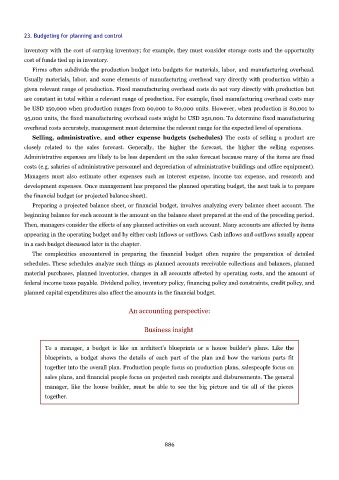Page 885 - Accounting Principles (A Business Perspective)
P. 885
23. Budgeting for planning and control
inventory with the cost of carrying inventory; for example, they must consider storage costs and the opportunity
cost of funds tied up in inventory.
Firms often subdivide the production budget into budgets for materials, labor, and manufacturing overhead.
Usually materials, labor, and some elements of manufacturing overhead vary directly with production within a
given relevant range of production. Fixed manufacturing overhead costs do not vary directly with production but
are constant in total within a relevant range of production. For example, fixed manufacturing overhead costs may
be USD 150,000 when production ranges from 60,000 to 80,000 units. However, when production is 80,001 to
95,000 units, the fixed manufacturing overhead costs might be USD 250,000. To determine fixed manufacturing
overhead costs accurately, management must determine the relevant range for the expected level of operations.
Selling, administrative, and other expense budgets (schedules) The costs of selling a product are
closely related to the sales forecast. Generally, the higher the forecast, the higher the selling expenses.
Administrative expenses are likely to be less dependent on the sales forecast because many of the items are fixed
costs (e.g. salaries of administrative personnel and depreciation of administrative buildings and office equipment).
Managers must also estimate other expenses such as interest expense, income tax expense, and research and
development expenses. Once management has prepared the planned operating budget, the next task is to prepare
the financial budget (or projected balance sheet).
Preparing a projected balance sheet, or financial budget, involves analyzing every balance sheet account. The
beginning balance for each account is the amount on the balance sheet prepared at the end of the preceding period.
Then, managers consider the effects of any planned activities on each account. Many accounts are affected by items
appearing in the operating budget and by either cash inflows or outflows. Cash inflows and outflows usually appear
in a cash budget discussed later in the chapter.
The complexities encountered in preparing the financial budget often require the preparation of detailed
schedules. These schedules analyze such things as planned accounts receivable collections and balances, planned
material purchases, planned inventories, changes in all accounts affected by operating costs, and the amount of
federal income taxes payable. Dividend policy, inventory policy, financing policy and constraints, credit policy, and
planned capital expenditures also affect the amounts in the financial budget.
An accounting perspective:
Business insight
To a manager, a budget is like an architect's blueprints or a house builder's plans. Like the
blueprints, a budget shows the details of each part of the plan and how the various parts fit
together into the overall plan. Production people focus on production plans, salespeople focus on
sales plans, and financial people focus on projected cash receipts and disbursements. The general
manager, like the house builder, must be able to see the big picture and tie all of the pieces
together.
886

